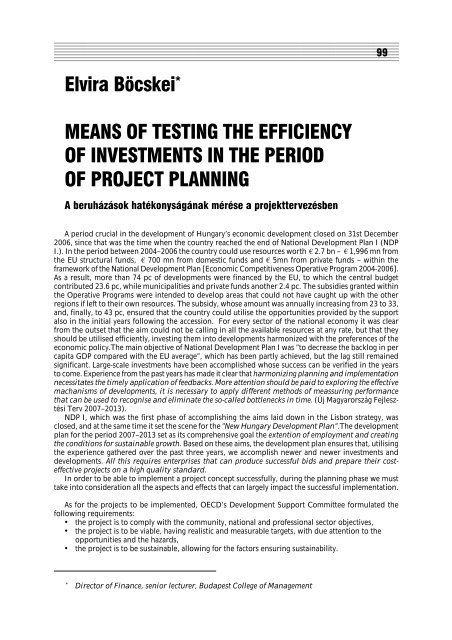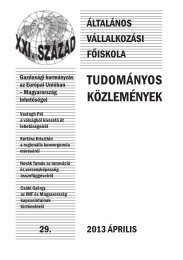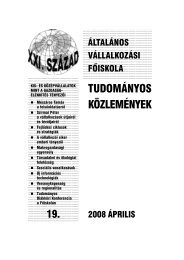Tudástársadalom, vállalkozások, Európa - Ãltalános Vállalkozási ...
Tudástársadalom, vállalkozások, Európa - Ãltalános Vállalkozási ...
Tudástársadalom, vállalkozások, Európa - Ãltalános Vállalkozási ...
You also want an ePaper? Increase the reach of your titles
YUMPU automatically turns print PDFs into web optimized ePapers that Google loves.
1234567890123456789012345678901212345678901234567890123456789012123456789012345678901234567890121234567890123456789012312345678901234567890123456789012123456789012345678901234567890121234567890123456789012345678901212345678901234567890123123456789012345678901234567890121234567890123456789012345678901212345678901234567890123456789012123456789012345678901231234567890123456789012345678901212345678901234567890123456789012123456789012345678901234567890121234567890123456789012312345678901234567890123456789012123456789012345678901234567890121234567890123456789012345678901212345678901234567890123123456789012345678901234567890121234567890123456789012345678901212345678901234567890123456789012123456789012345678901231234567890123456789012345678901212345678901234567890123456789012123456789012345678901234567890121234567890123456789012399Elvira Böcskei *MEANS OF TESTING THE EFFICIENCYOF INVESTMENTS IN THE PERIODOF PROJECT PLANNINGA beruházások hatékonyságának mérése a projekttervezésbenA period crucial in the development of Hungary’s economic development closed on 31st December2006, since that was the time when the country reached the end of National Development Plan I (NDPI.). In the period between 2004–2006 the country could use resources worth € 2.7 bn – € 1,996 mn fromthe EU structural funds, € 700 mn from domestic funds and € 5mn from private funds – within theframework of the National Development Plan [Economic Competitiveness Operative Program 2004-2006].As a result, more than 74 pc of developments were financed by the EU, to which the central budgetcontributed 23.6 pc, while municipalities and private funds another 2.4 pc. The subsidies granted withinthe Operative Programs were intended to develop areas that could not have caught up with the otherregions if left to their own resources. The subsidy, whose amount was annually increasing from 23 to 33,and, finally, to 43 pc, ensured that the country could utilise the opportunities provided by the supportalso in the initial years following the accession. For every sector of the national economy it was clearfrom the outset that the aim could not be calling in all the available resources at any rate, but that theyshould be utilised efficiently, investing them into developments harmonized with the preferences of theeconomic policy.The main objective of National Development Plan I was ”to decrease the backlog in percapita GDP compared with the EU average”, which has been partly achieved, but the lag still remainedsignificant. Large-scale investments have been accomplished whose success can be verified in the yearsto come. Experience from the past years has made it clear that harmonizing planning and implementationnecessitates the timely application of feedbacks. More attention should be paid to exploring the effectivemachanisms of developments, it is necessary to apply different methods of meassuring performancethat can be used to recognise and eliminate the so-called bottlenecks in time. (Új Magyarország FejlesztésiTerv 2007–2013).NDP I, which was the first phase of accomplishing the aims laid down in the Lisbon strategy, wasclosed, and at the same time it set the scene for the ”New Hungary Development Plan”.The developmentplan for the period 2007–2013 set as its comprehensive goal the extention of employment and creatingthe conditions for sustainable growth. Based on these aims, the development plan ensures that, utilisingthe experience gathered over the past three years, we accomplish newer and newer investments anddevelopments. All this requires enterprises that can produce successful bids and prepare their costeffectiveprojects on a high quality standard.In order to be able to implement a project concept successfully, during the planning phase we musttake into consideration all the aspects and effects that can largely impact the successful implementation.As for the projects to be implemented, OECD’s Development Support Committee formulated thefollowing requirements:• the project is to comply with the community, national and professional sector objectives,• the project is to be viable, having realistic and measurable targets, with due attention to theopportunities and the hazards,• the project is to be sustainable, allowing for the factors ensuring sustainability.*Director of Finance, senior lecturer, Budapest College of Management









